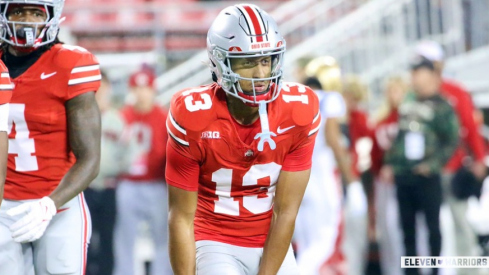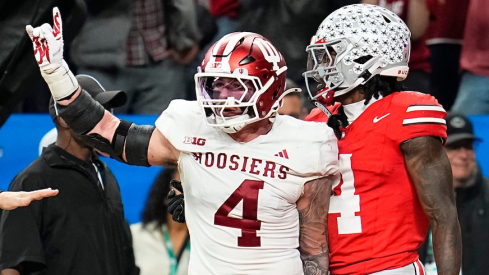BROOKLYN, Mich. – Champagne and confetti flew through the air and a racecar with a flat rear tire rolled into Victory Lane. Minutes before that tire ruptured during a celebratory burnout, former Ohio State football strength and conditioning staff member Ryan Patton jumped over the pit wall at Michigan International Speedway hugging the 75-pound piece of rubber as if it were an infant. He placed it on the No. 48 car and away Jimmie Johnson went.
Thirty-five laps later, Patton leaped over the wall again as Johnson crossed the start-finish line to take the checkered flag in the Quicken Loans 400, ending a career winless streak at MIS, thanks to a shrewd pit strategy by crew chief Chad Knaus.
“Everybody is involved in trying to calculate fuel strategy, it’s more than just the pit crew guys trying to do a good stop,” said Patton, Johnson’s rear-tire carrier and chassis adjuster. “This win is more rewarding because everyone has a hand in it.”
Patton, 28, a graduate of Delphos St. John’s and Ohio State, didn’t set out for a career in racing. If he won championships, he envisioned them as a Buckeye, not as a member of the Lowe’s Racing Team. But professional journeys tend to veer in different directions.
The shift for Patton, who admitted to never changing a tire until two years ago, came on a spring break trip to Charlotte when he was working for the Buckeyes. He traveled to Hendrick Motorsports’ headquarters to meet with the organization’s strength coach and observe training for the six-man pit crews to see how it correlated to training football players. What he found was the two sports, which may seem to be in different stratospheres, actually have several similar traits.
When a recruiting coordinator from Hendrick approached Patton, inviting him to their pit crew tryout, he didn’t hesitate at accepting. The combine, consisting of drills, tests and an assortment of other evaluations, whittled the field of 50 down to 10. The remaining hopefuls, vying for approximately a $70,000 payday prior to bonuses, then went through a rigorous two-day mini-camp, putting them in situations they’d face on the racetrack.
Patton got the job.
“Ryan is a great guy, valuable member to the team,” Johnson said. “He is strong on pit road and works hard.”
Patton, at Ohio State from 2007-2011, spent the 2012 racing season on a research and development pit crew, before getting the call from the bullpen early last season.
“The first pit stop I did was in the spring at Texas. I remember the car coming in and I jumped off the wall and thought, ‘Oh, my God, I’m pitting Jimmie Johnson’s car.’ I kind of blacked out. You do this so many times it’s like a golf swing. It sounds funny, but the less that you think, the better you are.
“I can’t remember the first couple stops. To this day I don’t know what happened unless I see the film. Now, since I’ve been on the car for a year, everything slows down a little bit and I notice some things. That’s what separates the guys who’ve done this a long time. They know what to look for and hear.”
The same preparation, thoughts and strategy translate from football to NASCAR. In recent years, weekends at the racetrack mimic Saturdays and Sundays in college and NFL towns due to an influx of former football players – as well as hockey, baseball and wrestling. But football is where NASCAR has made its biggest pitch.
Athletic ability first became evident in the mid-1990s when Hendrick driver Jeff Gordon and his Rainbow Warrior pit crew – Knaus was a tire changer – won three championships. No longer did a pit crew consist of large bellies and cigarette smokers. But the full revolution didn’t begin until the turn of the 21st century.
“What happens as things evolve in every sport, but especially in NASCAR, you’re always trying to find areas you can be better in,” Gordon said. “Several years ago, crew chiefs started looking in areas where they could be more consistent and quicker on pit road. You can gain two and three positions under caution, or lose them. Those positions are harder and harder to gain back these days.
“We put a lot of effort into hiring the right people, as well as how hard we train them. Just looking at how athletes train for other sports and getting them as fit as they can be and then detailing it for the job they do on pit road.”
Andy Papathanassiou, a former Stanford football player who is now Hendrick’s director of human performance, simplifies the philosophy as you can teach an athlete about a racecar, but you can’t teach a mechanic to be athletic. Hendrick’s mentality has filtered throughout the NASCAR series, where bigger, faster, stronger meets quick and efficient.
“These athletes are starting to understand racing and understand the pressures that are involved to pit a race car for a guy like Jimmie Johnson,” Knaus said. “It’s tough, especially when you have cameras on your grille watching every move, and as soon as you make a mistake, you get blasted in the media and the paper and everything else. These guys are starting to become numb to that type of pressure.”
Estimates are that 70-80 percent of pit crews are former athletes. Johnson’s crew contains five people with close connections to college sports – three former college football players, a college baseball player and Patton. In NASCAR, tenths of a second are the football equivalent to inches. Twelve-second four-tire pit stops are the expectation. If perfection isn’t achieved, the stop could be 12.3 seconds, the difference between first and second.
That scenario played out at MIS Sunday when Kevin Harvick had a longer-than-usual pit stop. It cost him multiple positions on the racetrack and he ultimately finished second to Johnson.
“There are so many changes [to pit crews].” Johnson said. “The pit stops used to be 20 seconds, and now they are 12. We have a huge focus on human performance at Hendrick Motorsports, and the pit crews have really become specialized. It’s become important and we have seen some success with [former athletes]. They have been in the heat of competition before, they know how to deal with pressure, they take care of their bodies and are in amazing shape. It’s very important.”
As in, their job is routinely on the line. Patton’s only had one major gaffe on pit road, leading Knaus, notorious for his obsessive chase for perfection, to make his displeasure known.
At the 2013 All-Star Race, Knaus called for an adjustment on the car. Patton made the correct adjustment, but a sense of doubt crept over him, so he reversed course. The reversal meant he essentially did nothing to the car. Johnson still won the race – and $1 million.
“Chad wasn’t too happy,” Patton recalled, with a chuckle. “Knock on wood that’s the only big screw up I have.”
Race week preparations are highly structured and detailed undertakings. There are weight lifting sessions, film study and practices with crowd and engine noise piped in. As Braxton Miller analyzes opposing defenses, Patton reviews the previous race to see the good and the bad.
The competitiveness and groundwork knows no bounds in Charlotte, the hub of NASCAR. Hendrick Motorsports, home to Johnson, Gordon and Dale Earnhardt Jr., occupies the catbird seat.
“It’s the best of the best and the elite of the elite,” Patton said. “It’s like playing for the New York Yankees.”
Another comparison would be playing alongside Michael Jordan. Johnson is a six-time champion in the Sprint Cup Series, with his most recent title coming last season, an experience Patton still relishes.
“It was incredible, he said. “We just kind of gelled. You don’t really get wrapped up into too much. It’s just one race, one pit stop at a time. Jimmie is a great driver, so we felt if we just did our job and put him in position, we had a good chance. I tried not to think about too much until the last lap at Homestead. Then you celebrate all the hard work all year long paying off.”
There were interested family and friends, including former Ohio State players Patton still keeps in touch with, watching Johnson’s title chase. Another former Buckeye who was an interested observer was Jim Tressel.
“As they were marching last year toward their championship, he’d say, ‘Coach, this is just like getting ready for a game. Everything we learned at Ohio State [transfers to racing],’” said Tressel, who admitted to having a Johnson hat and racecar in his office. “It’s exciting to watch what [Patton’s] done.”
Patton looks back fondly at his time at Ohio State. Lifelong lessons and friendships were made. He points to his privilege of working with good people and those who were successful at the top of their sport. He’s facing a repeat of that situation with Johnson. Eventually, he might do so again in the sport of football.
The career lifespan of a pit crew member is in the seven-year range. Patton is aware of that reality, and even though he’s young, fit and in his second year, Patton has an eye toward the future.
Growing up in the northwestern Ohio city of Delphos, less than four square miles, Patton believed he would be a football coach. He now wants to stay in the strength and conditioning field, but only after his NASCAR career comes to an end.
Until then, he wants to be involved in racing, a sport he’s treasured since he attended races in Indianapolis and Michigan as a young boy with his grandfather and dad. His dad raced go-karts, acting as Patton’s introduction to racing.
On Sunday, less than 100 miles from his boyhood home, Patton embraced his dad amid the celebration and hoopla on the MIS infield, taking in the moment with laughs and high fives.
Said Patton: “To have my parents here in Victory Lane on Father’s Day is really special.”

